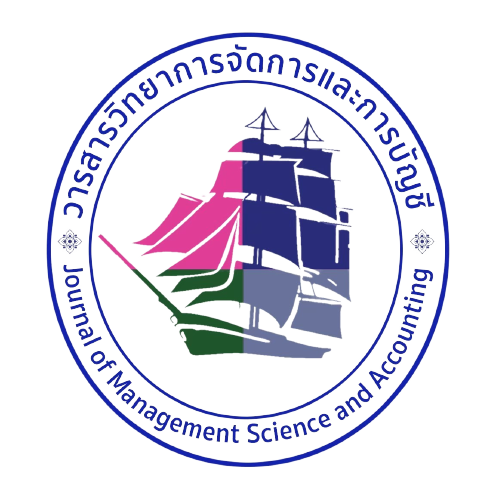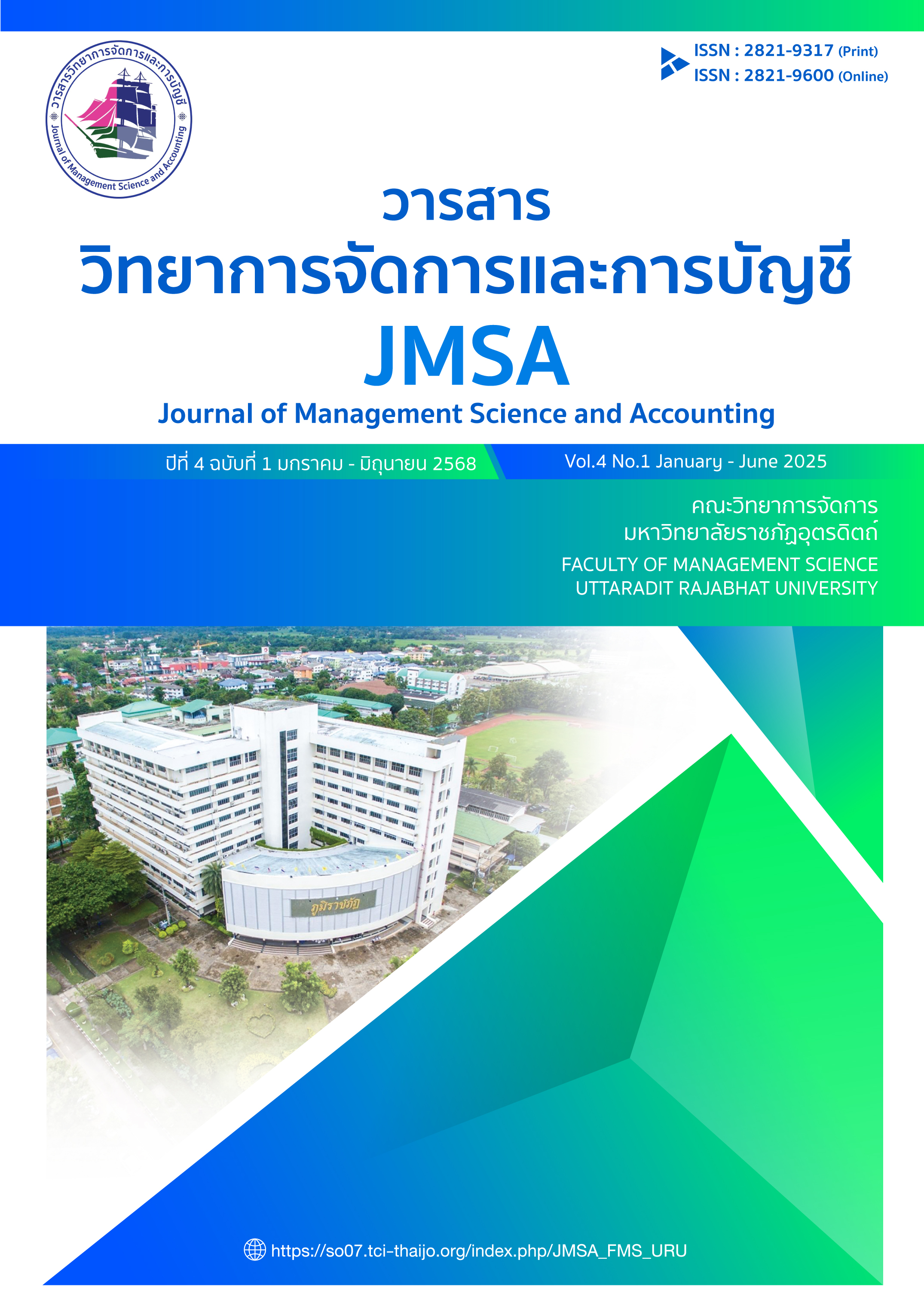อิทธิพลของการวางกลยุทธ์ทางด้านเทคโนโลยีสารสนเทศในองค์กรที่ส่งผลต่อประสิทธิภาพการดำเนินงานของธุรกิจในอุตสาหกรรมส่วนประกอบยานยนต์
Main Article Content
บทคัดย่อ
การศึกษาวิจัยนี้มีวัตถุประสงค์เพื่อศึกษาปัจจัยที่สนับสนุนการวางกลยุทธ์เทคโนโลยีสารสนเทศที่มีอิทธิพลและความสัมพันธ์ต่อประสิทธิภาพการการดำเนินงานของอุตสาหกรรมส่วนประกอบยานยนต์ กลุ่มตัวอย่างคือ ผู้ที่มีส่วนเกี่ยวข้องกับระบบสารสนเทศในองค์กรของอุตสาหกรรมส่วนประกอบยานยนต์คือ ผู้บริหารด้านเทคโนโลยีสารสนเทศ, ผู้จัดการฝ่ายเทคโนโลยีสารสนเทศ และเจ้าหน้าที่ปฏิบัติการสารสนเทศ จำนวน 180 ราย คัดเลือกโดยการสุ่มตัวอย่างแบบแบ่งชั้นตามวัตถุประสงค์ สถิติที่ใช้ในการวิเคราะห์ข้อมูล การวิเคราะห์โมเดลสมการโครงสร้าง (SEM)
ผลการวิจัย พบว่า โมเดลการวิเคราะห์มีความสอดคล้องกับข้อมูลเชิงประจักษ์ ผลลัพธ์ระบุว่าแบบจำลองมีสัดส่วนและการถดถอยของสมมติฐานทั้งหมดได้รับการยอมรับด้วยค่า p < 0.05 ส่วนผลการตรวจสอบความสอดคล้องและกลมกลืนพบว่ามีความสอดคล้องกับองค์ประกอบย่อยของโมเดลเชิงโครงสร้าง โดยมีค่า /df = 2.425, GFI = 0.946 , AGFI = 0.878 , RMR = 0.050, RMSEA = 0.089 , NFI = 0.971, CFI = 0.982 สำหรับผลทดสอบสมมติฐานพบว่า การวางกลยุทธ์เทคโนโลยีสารสนเทศ มีผลกระทบโดยตรงทางบวกต่อประสิทธิภาพการดำเนินงาน ในด้านของ การให้คำแนะนำและการมีส่วนร่วม และการกำหนดขอบเขตของงาน นอกจากนี้การให้ความสำคัญในด้านของความต่อเนื่องของข้อมูล และด้านความปลอดภัยของข้อมูลที่ดีจะช่วยเพิ่มประสิทธิภาพในการดำเนินงานขององค์กรให้สูงขึ้น
Article Details

อนุญาตภายใต้เงื่อนไข Creative Commons Attribution-NonCommercial-NoDerivatives 4.0 International License.
บทความที่ได้รับการตีพิมพ์ในวารสารวิทยาการจัดการและการบัญชี มหาวิทยาลัยราชภัฏอุตรดิตถ์ เป็นลิขสิทธิ์ของมหาวิทยาลัยราชภัฎอุตรดิตถ์
บทความที่ลงตีพิมพ์ใน วารสารวิทยาการจัดการและการบัญชี มหาวิทยาลัยราชภัฎอุตรดิตถ์ ถือว่าเป็นความเห็นส่วนตัวของผู้เขียน คณะบรรณาธิการไม่จำเป็นต้องเห็นด้วย ผู้เขียนต้องรับผิดชอบต่อบทความของตนเอง
ผู้เขียนที่ตีพิมพ์ ยอมรับเงื่อนไขต่อไปนี้:
- ผู้เขียนรักษาลิขสิทธิ์และให้สิทธิ์วารสารในการตีพิมพ์ครั้งแรกพร้อมกับผลงานที่ได้รับใบอนุญาตพร้อมกันภายใต้ Attribution-NonCommercial-NoDerivatives 4.0 International (CC BY-NC-ND 4.0) ที่อนุญาตให้ผู้อื่นแบ่งปันผลงานโดยรับทราบถึงผลงานของผู้เขียนและ การตีพิมพ์ครั้งแรกในวารสารนี้
- ผู้เขียนสามารถทำข้อตกลงเพิ่มเติมตามสัญญาแยกต่างหากสำหรับการเผยแพร่ผลงานฉบับตีพิมพ์ของวารสารแบบไม่ผูกขาด (เช่น โพสต์ลงในพื้นที่เก็บข้อมูลของสถาบันหรือตีพิมพ์ในหนังสือ) โดยรับทราบการตีพิมพ์ครั้งแรก ในวารสารนี้
- ผู้เขียนได้รับอนุญาตและสนับสนุนให้โพสต์ผลงานของตนทางออนไลน์ (เช่น ในคลังข้อมูลของสถาบันหรือบนเว็บไซต์) ก่อนและระหว่างขั้นตอนการส่งผลงาน เนื่องจากอาจนำไปสู่การแลกเปลี่ยนที่มีประสิทธิผล ตลอดจนการอ้างอิงงานที่ตีพิมพ์เร็วขึ้นและมากขึ้น
เอกสารอ้างอิง
Akbarovna, N. N. (2024). STRATEGIC MANAGEMENT METHODS IN AN INNOVATIVE ECONOMY. MODERN EDUCATIONAL SYSTEM AND INNOVATIVE TEACHING SOLUTIONS, 1(3), 407-412.
Alarcón, D., Sánchez, J. A., & De Olavide, U. (2015). Assessing convergent and discriminant validity in the ADHD-R IV rating scale: User-written commands for Average Variance Extracted (AVE), Composite Reliability (CR), and Heterotrait-Monotrait ratio of correlations (HTMT). Paper presented at the Spanish STATA meeting.
Appelbaum, S. H., St‐Pierre, N., & Glavas, W. (1998). Strategic organizational change: the role of leadership, learning, motivation and productivity. Management decision, 36(5), 289-301.
Bashar, A., Sakib, M. N., Rahman, M. M., Tabassum, F., & Sabah, S. (2024). The role of top management commitment, employee involvement, and training and development on employee performance: evidence from the banking sector of an emerging economy. Quality Management Journal, 31(1), 58-74.
Brenner, W., & Herrmann, A. (2018). An overview of technology, benefits and impact of automated and autonomous driving on the automotive industry. Digital marketplaces unleashed, 427-442.
Den Hond, F., Rehbein, K. A., De Bakker, F. G., & Lankveld, H. K. v. (2014). Playing on two chessboards: Reputation effects between corporate social responsibility (CSR) and corporate political activity (CPA). Journal of management studies, 51(5), 790-813.
Faulkner, A., & Thompson, R. (2023). Uncovering the emotional labour of involvement and co-production in mental health research. Disability & Society, 38(4), 537-560.
Fernando, Y., Jabbour, C. J. C., & Wah, W.-X. (2019). Pursuing green growth in technology firms through the connections between environmental innovation and sustainable business performance: does service capability matter? Resources, conservation and recycling, 141, 8-20.
Fornell, C., & Larcker, D. F. (1981). Evaluating structural equation models with unobservable variables and measurement error. Journal of marketing research, 18(1), 39-50.
Gaol, F. L., Deniansyah, M. F., & Matsuo, T. (2023). The measurement impact of ERP system implementation on the automotive industry business process efficiency. International Journal of Business Information Systems, 43(3), 429-442.
Guyatt, G. H., Townsend, M., Berman, L. B., & Keller, J. L. (1987). A comparison of Likert and visual analogue scales for measuring change in function. Journal of chronic diseases, 40(12), 1129-1133.
Hair, J., Hollingsworth, C. L., Randolph, A. B., & Chong, A. Y. L. (2017). An updated and expanded assessment of PLS-SEM in information systems research. Industrial management & data systems, 117(3), 442-458.
Jongwanich, J. (2024). Free trade agreements (FTAs) and export structures: evidence from Thailand. Journal of the Asia Pacific Economy, 1-39.
Karwowski, M., & Raulinajtys‐Grzybek, M. (2021). The application of corporate social responsibility (CSR) actions for mitigation of environmental, social, corporate governance (ESG) and reputational risk in integrated reports. Corporate Social Responsibility and Environmental Management, 28(4), 1270-1284.
Legate, A. E., Hair Jr, J. F., Chretien, J. L., & Risher, J. J. (2023). PLS‐SEM: Prediction‐oriented solutions for HRD researchers. Human Resource Development Quarterly, 34(1), 91-109.
Lorgnier, N. G., Chanavat, N., Su, C.-J., & O’Rourke, S. M. (2020). Examining the influence of brand-based value congruity: do the values of the International Olympic Committee really matter? Service Business, 14, 73-99.
McElhaney, K. (2009). A strategic approach to corporate social responsibility. Leader to leader, 52(1), 30-36.
Mishra, A., Dutta, P., Jayasankar, S., Jain, P., & Mathiyazhagan, K. (2023). A review of reverse logistics and closed-loop supply chains in the perspective of circular economy. Benchmarking: an international journal, 30(3), 975-1020.
Naranjo-Gil, D., & Hartmann, F. (2007). How CEOs use management information systems for strategy implementation in hospitals. Health Policy, 81(1), 29-41.
Pomaza-Ponomarenko, A., Kryvova, S., Hordieiev, A., Hanzyuk, A., & Halunko, O. (2023). Innovative risk management: identification, assessment and management of risks in the context of innovative project management.
Rachmad, Y. E. (2023). Engagement Influence Theory: Peshawar Khyber Kitab Ishaat, Khaas Edition.
Song, M., Pan, H., Vardanyan, M., & Shen, Z. (2023). Evaluating the energy efficiency-enhancing potential of the digital economy: Evidence from China. Journal of Environmental Management, 344, 118408.
Vilagut, G. (2024). Test-retest reliability Encyclopedia of quality of life and well-being research (pp. 7180-7184): Springer.
Wolf, E. J., Harrington, K. M., Clark, S. L., & Miller, M. W. (2013). Sample size requirements for structural equation models: An evaluation of power, bias, and solution propriety. Educational and psychological measurement, 73(6), 913-934.
Worimegbe, P. M., Abosede, A. J., & Worimegbe, T. M. (2018). Efficiency, customers’ satisfaction and deposit money banks’ performance in Nigeria. Journal of Economics and Management, 31, 133-148.


